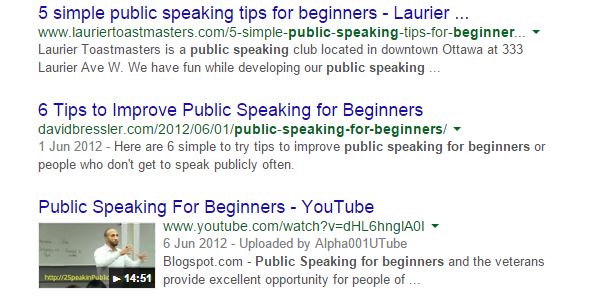Of all the SEO questions we get asked one that is becoming increasingly common is just how important a role video plays in SEO. Is video an essential component of your online marketing? How can you use video in your campaigns? Will your rankings tank if you don’t start using video? [Insert your other semi-ridiculous video SEO questions here.]
This post will take a look at these questions and provide some general guidelines for when a video is and isn’t a good idea.
Paint by Numbers
Is blogging good for SEO? Social Media? Video? Surely if you want good SEO you have to have a blog right? The problem here is that ‘SEO’ is not some checklist (although it kind of used to be) and really what we are trying to do is generate more exposure in the search engines but this is not achieved from half-heartedly participating in a laundry list of activities. This is what I like to call the SEO by numbers mentality and guess what folks… it does not work (shocker). Simply having a blog, some social media channels and a few youtube videos does not give you good ‘SEO’.
Video SEO is dead
An important note is that what was typically once considered video SEO was to generate rich snippets in the search results to drive increased click rates. Unfortunately, rich video snippets have been phased out for most sites (along with author snippets) and now only dedicated video sites like youtube.com (mostly youtube.com) benefit from rich snippets in the standard search results. You can still benefit from these rich snippets if searching in the ‘videos’ tab on Google search so all is not lost (just mostly). This is a great post on the rise and fall of rich snippets.
From awareness to advocacy
Let’s start by looking at our general marketing goals. What are we trying to achieve? Chances are we have a few major goals but the main ones will likely be:
- Awareness – Drive more awareness and interest with our target audience
- Consideration – Get our prospects to seriously consider our offering amongst the competition
- Conversion – convince prospects to take the leap
We could also tag advocacy on to this list to help convince our happy customers to recommend us to their friends and pop them in at the awareness & consideration stages – nothing quite like the positive power of referrals after all!
So where does video fit into this?
Okay, so if we are clear about what we are trying to achieve then we can better start to see how video can fit into this picture. With most marketing the starting point is awareness so adding a video to your own site is unlikely to generate that many views. Adding a video to youtube.com may see more traction. In practice when you are starting out you will need to create videos that people can find and engage with whilst already on youtube.com or other video sites. Then, when these videos get some solid engagement behind them they may well start to do better in organic search results (with that rich snippet helping them get more clicks).
Here is an example of a Google SERP with a video snippet – which one would you click?

The main takeaway here is that we have to think about the users and create something of value – we can’t simply SEO by numbers and the content has to be useful and relevant and we have to build up our audience.
When we are looking at consideration or conversion often these videos are better suited on your site itself. Not to say they can’t live on youtube.com as well and be embedded from there but these are videos we want to use to help move that customer ever closer to making that first enquiry so they should predominantly feature on your own site.
The best answer
Another consideration here is providing the best possible answer. Google loves to provide A) the best answer to a given query and B) good diversity in the results. So, if you can spot an area where there is not a great answer or there are no video answers and video would be a good media to answer a given question then that could be an opportunity and could streamline getting your video ranked. As an example, a plumber could write an article on how to fix a leaky tap but a video would be a much better way to answer that question. Again, you can’t dial this in so being the best answer is the best possible start.
The bigger picture
We also have to remember that video should just be a part of your marketing channel – as an example, you can link youtube.com and Google Adwords and then remarket your business with banners and text adverts on the Google display network. So, if you are using video to drive awareness and qualify potential prospects you can build on that and further educate or just stay in front of your customers in a cost effective way using remarketing.
What kind of video should you release?
So, what kind of videos should you put out there? Again, this is very, very specific to the individual business but concentrating on the awareness angle we really want to provide content that is helpful to our target audience. In the online marketing world, we can create screencasts of setting up various tools (Google analytics is hugely complicated so makes a good one). A nationwide plumber could provide videos of fixing various basic home plumbing problems. A financial advisor could offer feedback on various investment opportunities. The list is really endless but the real trick here is to do things that are really helpful to your target audience.
We recently worked with a company that had a vast library of training videos on VHS tapes. We used a local company to convert the VHS & camcorder tapes to DVD and digital formats and then with some simple editing to add titles and branding we had a ready to go library of content to upload.
The main takeaway here is that the ideas don’t have to be complicated and you may already have well-performing content that can be re-purposed or recreated as video – but for awareness just keep it useful and don’t try to make the sale!
Where to host your video
For most folks, youtube.com is going to be the best place to host. You could potentially put the video out on other channels like Vimeo or Dailymotion but in many cases, youtube.com will do the job and having one authoritative version of your videos tends to be my preferred (paranoid?) approach. If you want to keep certain videos private or want improved analytics or options then professional video hosting solutions like Wistia can do the job admirably (but for most businesses this is likely overkill).
Basic Video SEO
Once we know what we want to host and are 100% clear on our goals we can create and upload our videos to youtube.com but we still have to get the SEO basics right. We don’t need to overcomplicate this and many of the signals we want are driven by engagement (likes, views, comments etc) but we want to make sure we give the video a good descriptive title. We also want a well-written description. Don’t be afraid to go a bit long here and use your keywords in a natural way.
Additionally, if you can edit your videos to include some encouragement or incentive for folks to like, follow and share then you can help drive those all-important engagement metrics and expedite getting these videos in the organic search results – which is a good thing! As your video library grows you can utilise keyword based playlists to further improve your likelihood of being found.
It’s really simple to do basic video editing in free tools like iMovie or even the fairly ghastly Windows Movie Maker but there are also plenty of companies that can help edit your video. For the VHS example above we worked with a company close to us called www.vinyltodigital.co.uk who added the branding, an intro and an outro that reinforced the brand and helped encourage sharing and follows.
The last tweak is to use the annotations in youtube that allow you to add links to your videos. These are often abused and can be incredibly annoying so don’t go overboard but don’t be afraid to ask someone to follow you for more high-quality free advice – remember, we are just being helpful at this stage to raise brand awareness and drive people to the top of our marketing funnel.
Ready to go?






